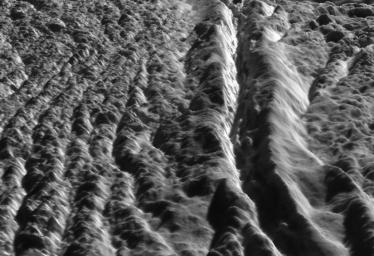Perspective view of Damascus Sulcus, Enceladus
Caption:
This perspective view of Damascus Sulcus was generated using high resolution images of Enceladus acquired in August 2008 at 12 to 30 meters (40 to 100 feet) resolution, together with a new topographic map of the region produced by Dr. Paul Schenk (
http://www.lpi.usra.edu/lpi/schenk/
) at the Lunar and Planetary Institute in Houston, TX. Damascus Sulcus is one of several prominent linear structures, dubbed "tiger stripes," within the geologically active south polar region of Enceladus. Damascus Sulcus consists of two large parallel ridges separated by a deep V-shaped medial trough. The ridges are each 100 to 150 meters high (325 to 500 feet), while the entire width of Damascus Sulcus is 5 kilometers (3 miles). The medial trough between the ridges is 200 to 250 meters (650 to 820 feet) deep, and may have formed by daily shear (sliding) faulting triggered by tidal forces. These medial troughs may be the primary source of numerous jets making up the large active water vapor plume over the south pole of Enceladus. Several small ridges can be seen along the floor of the medial trough. These could be blocks of crust that have slid down the walls of the trough or fractured blocks pushed up from below. Flanking Damascus Sulcus are repeating sets of broken and disrupted parallel ridges a few tens of meters high. These are typical of the plains that lie between the tiger stripe structures and resemble crumpled or folded rock patterns seen on Earth. Relief has been exaggerated by a factor of ~10 to enhance clarity.
Background Info:
The raw data from which this product was developed were retrieved from the Planetary Data System's Cassini archives. The Cassini-Huygens mission is a cooperative project of NASA, the European Space Agency and the Italian Space Agency. The Jet Propulsion Laboratory, a division of the California Institute of Technology in Pasadena, manages the mission for NASA's Science Mission Directorate, Washington, D.C. The Cassini orbiter and its two onboard cameras were designed, developed and assembled at JPL. The imaging operations center is based at the Space Science Institute in Boulder, Colo. (
http://ciclops.org
)
Cataloging Keywords:
| Name |
Value |
Additional Values |
| Target |
Enceladus |
|
| System |
Saturn |
|
| Target Type |
Satellite |
|
| Mission |
Cassini-Huygens |
|
| Instrument Host |
Cassini Orbiter |
|
| Host Type |
Orbiter |
|
| Instrument |
Imaging Science Subsystem (ISS) |
|
| Detector |
|
|
| Extra Keywords |
Grayscale, Map, Plume, Water |
| Acquisition Date |
|
| Release Date |
2009-09-21 |
| Date in Caption |
|
|
| Image Credit |
NASA/JPL/Space Science Institute/Universities Space Research Association/Lunar & Planetary Institute |
| Source |
photojournal.jpl.nasa.gov/catalog/PIA12207 |
| Identifier |
PIA12207 |

 Planetary Data System
Planetary Data System
